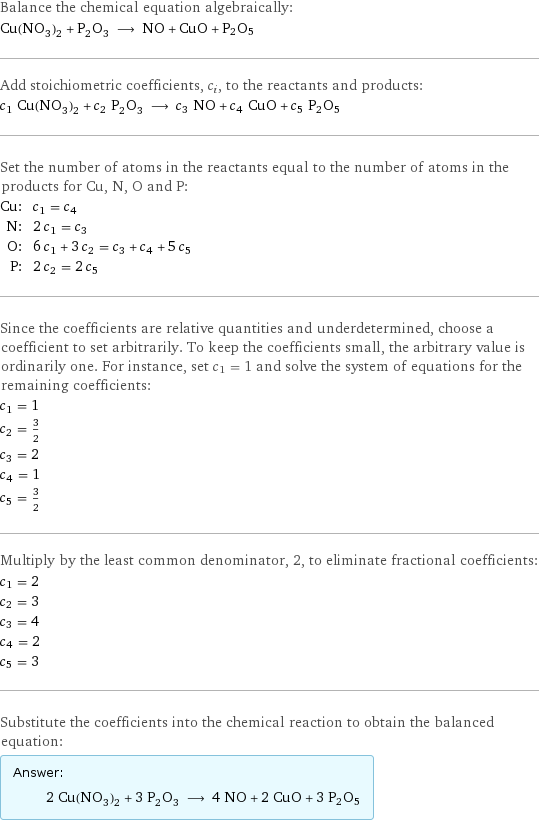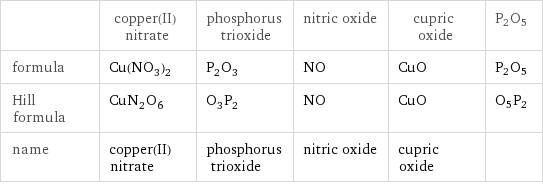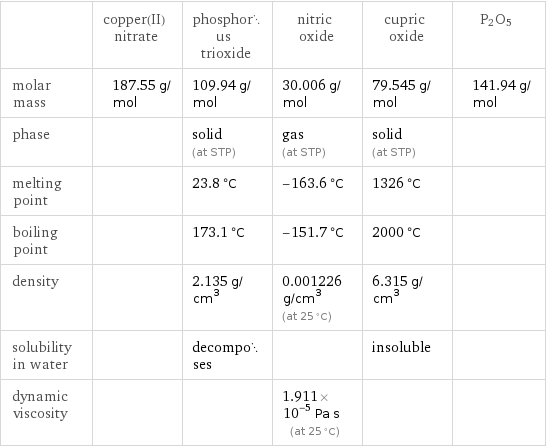Input interpretation

Cu(NO_3)_2 copper(II) nitrate + P_2O_3 phosphorus trioxide ⟶ NO nitric oxide + CuO cupric oxide + P2O5
Balanced equation

Balance the chemical equation algebraically: Cu(NO_3)_2 + P_2O_3 ⟶ NO + CuO + P2O5 Add stoichiometric coefficients, c_i, to the reactants and products: c_1 Cu(NO_3)_2 + c_2 P_2O_3 ⟶ c_3 NO + c_4 CuO + c_5 P2O5 Set the number of atoms in the reactants equal to the number of atoms in the products for Cu, N, O and P: Cu: | c_1 = c_4 N: | 2 c_1 = c_3 O: | 6 c_1 + 3 c_2 = c_3 + c_4 + 5 c_5 P: | 2 c_2 = 2 c_5 Since the coefficients are relative quantities and underdetermined, choose a coefficient to set arbitrarily. To keep the coefficients small, the arbitrary value is ordinarily one. For instance, set c_1 = 1 and solve the system of equations for the remaining coefficients: c_1 = 1 c_2 = 3/2 c_3 = 2 c_4 = 1 c_5 = 3/2 Multiply by the least common denominator, 2, to eliminate fractional coefficients: c_1 = 2 c_2 = 3 c_3 = 4 c_4 = 2 c_5 = 3 Substitute the coefficients into the chemical reaction to obtain the balanced equation: Answer: | | 2 Cu(NO_3)_2 + 3 P_2O_3 ⟶ 4 NO + 2 CuO + 3 P2O5
Structures

+ ⟶ + + P2O5
Names

copper(II) nitrate + phosphorus trioxide ⟶ nitric oxide + cupric oxide + P2O5
Equilibrium constant
![Construct the equilibrium constant, K, expression for: Cu(NO_3)_2 + P_2O_3 ⟶ NO + CuO + P2O5 Plan: • Balance the chemical equation. • Determine the stoichiometric numbers. • Assemble the activity expression for each chemical species. • Use the activity expressions to build the equilibrium constant expression. Write the balanced chemical equation: 2 Cu(NO_3)_2 + 3 P_2O_3 ⟶ 4 NO + 2 CuO + 3 P2O5 Assign stoichiometric numbers, ν_i, using the stoichiometric coefficients, c_i, from the balanced chemical equation in the following manner: ν_i = -c_i for reactants and ν_i = c_i for products: chemical species | c_i | ν_i Cu(NO_3)_2 | 2 | -2 P_2O_3 | 3 | -3 NO | 4 | 4 CuO | 2 | 2 P2O5 | 3 | 3 Assemble the activity expressions accounting for the state of matter and ν_i: chemical species | c_i | ν_i | activity expression Cu(NO_3)_2 | 2 | -2 | ([Cu(NO3)2])^(-2) P_2O_3 | 3 | -3 | ([P2O3])^(-3) NO | 4 | 4 | ([NO])^4 CuO | 2 | 2 | ([CuO])^2 P2O5 | 3 | 3 | ([P2O5])^3 The equilibrium constant symbol in the concentration basis is: K_c Mulitply the activity expressions to arrive at the K_c expression: Answer: | | K_c = ([Cu(NO3)2])^(-2) ([P2O3])^(-3) ([NO])^4 ([CuO])^2 ([P2O5])^3 = (([NO])^4 ([CuO])^2 ([P2O5])^3)/(([Cu(NO3)2])^2 ([P2O3])^3)](../image_source/c9ed180634090bf8a6e15ae4ca7571fe.png)
Construct the equilibrium constant, K, expression for: Cu(NO_3)_2 + P_2O_3 ⟶ NO + CuO + P2O5 Plan: • Balance the chemical equation. • Determine the stoichiometric numbers. • Assemble the activity expression for each chemical species. • Use the activity expressions to build the equilibrium constant expression. Write the balanced chemical equation: 2 Cu(NO_3)_2 + 3 P_2O_3 ⟶ 4 NO + 2 CuO + 3 P2O5 Assign stoichiometric numbers, ν_i, using the stoichiometric coefficients, c_i, from the balanced chemical equation in the following manner: ν_i = -c_i for reactants and ν_i = c_i for products: chemical species | c_i | ν_i Cu(NO_3)_2 | 2 | -2 P_2O_3 | 3 | -3 NO | 4 | 4 CuO | 2 | 2 P2O5 | 3 | 3 Assemble the activity expressions accounting for the state of matter and ν_i: chemical species | c_i | ν_i | activity expression Cu(NO_3)_2 | 2 | -2 | ([Cu(NO3)2])^(-2) P_2O_3 | 3 | -3 | ([P2O3])^(-3) NO | 4 | 4 | ([NO])^4 CuO | 2 | 2 | ([CuO])^2 P2O5 | 3 | 3 | ([P2O5])^3 The equilibrium constant symbol in the concentration basis is: K_c Mulitply the activity expressions to arrive at the K_c expression: Answer: | | K_c = ([Cu(NO3)2])^(-2) ([P2O3])^(-3) ([NO])^4 ([CuO])^2 ([P2O5])^3 = (([NO])^4 ([CuO])^2 ([P2O5])^3)/(([Cu(NO3)2])^2 ([P2O3])^3)
Rate of reaction
![Construct the rate of reaction expression for: Cu(NO_3)_2 + P_2O_3 ⟶ NO + CuO + P2O5 Plan: • Balance the chemical equation. • Determine the stoichiometric numbers. • Assemble the rate term for each chemical species. • Write the rate of reaction expression. Write the balanced chemical equation: 2 Cu(NO_3)_2 + 3 P_2O_3 ⟶ 4 NO + 2 CuO + 3 P2O5 Assign stoichiometric numbers, ν_i, using the stoichiometric coefficients, c_i, from the balanced chemical equation in the following manner: ν_i = -c_i for reactants and ν_i = c_i for products: chemical species | c_i | ν_i Cu(NO_3)_2 | 2 | -2 P_2O_3 | 3 | -3 NO | 4 | 4 CuO | 2 | 2 P2O5 | 3 | 3 The rate term for each chemical species, B_i, is 1/ν_i(Δ[B_i])/(Δt) where [B_i] is the amount concentration and t is time: chemical species | c_i | ν_i | rate term Cu(NO_3)_2 | 2 | -2 | -1/2 (Δ[Cu(NO3)2])/(Δt) P_2O_3 | 3 | -3 | -1/3 (Δ[P2O3])/(Δt) NO | 4 | 4 | 1/4 (Δ[NO])/(Δt) CuO | 2 | 2 | 1/2 (Δ[CuO])/(Δt) P2O5 | 3 | 3 | 1/3 (Δ[P2O5])/(Δt) (for infinitesimal rate of change, replace Δ with d) Set the rate terms equal to each other to arrive at the rate expression: Answer: | | rate = -1/2 (Δ[Cu(NO3)2])/(Δt) = -1/3 (Δ[P2O3])/(Δt) = 1/4 (Δ[NO])/(Δt) = 1/2 (Δ[CuO])/(Δt) = 1/3 (Δ[P2O5])/(Δt) (assuming constant volume and no accumulation of intermediates or side products)](../image_source/77048eab72874eea244f8fcde00694da.png)
Construct the rate of reaction expression for: Cu(NO_3)_2 + P_2O_3 ⟶ NO + CuO + P2O5 Plan: • Balance the chemical equation. • Determine the stoichiometric numbers. • Assemble the rate term for each chemical species. • Write the rate of reaction expression. Write the balanced chemical equation: 2 Cu(NO_3)_2 + 3 P_2O_3 ⟶ 4 NO + 2 CuO + 3 P2O5 Assign stoichiometric numbers, ν_i, using the stoichiometric coefficients, c_i, from the balanced chemical equation in the following manner: ν_i = -c_i for reactants and ν_i = c_i for products: chemical species | c_i | ν_i Cu(NO_3)_2 | 2 | -2 P_2O_3 | 3 | -3 NO | 4 | 4 CuO | 2 | 2 P2O5 | 3 | 3 The rate term for each chemical species, B_i, is 1/ν_i(Δ[B_i])/(Δt) where [B_i] is the amount concentration and t is time: chemical species | c_i | ν_i | rate term Cu(NO_3)_2 | 2 | -2 | -1/2 (Δ[Cu(NO3)2])/(Δt) P_2O_3 | 3 | -3 | -1/3 (Δ[P2O3])/(Δt) NO | 4 | 4 | 1/4 (Δ[NO])/(Δt) CuO | 2 | 2 | 1/2 (Δ[CuO])/(Δt) P2O5 | 3 | 3 | 1/3 (Δ[P2O5])/(Δt) (for infinitesimal rate of change, replace Δ with d) Set the rate terms equal to each other to arrive at the rate expression: Answer: | | rate = -1/2 (Δ[Cu(NO3)2])/(Δt) = -1/3 (Δ[P2O3])/(Δt) = 1/4 (Δ[NO])/(Δt) = 1/2 (Δ[CuO])/(Δt) = 1/3 (Δ[P2O5])/(Δt) (assuming constant volume and no accumulation of intermediates or side products)
Chemical names and formulas

| copper(II) nitrate | phosphorus trioxide | nitric oxide | cupric oxide | P2O5 formula | Cu(NO_3)_2 | P_2O_3 | NO | CuO | P2O5 Hill formula | CuN_2O_6 | O_3P_2 | NO | CuO | O5P2 name | copper(II) nitrate | phosphorus trioxide | nitric oxide | cupric oxide |
Substance properties

| copper(II) nitrate | phosphorus trioxide | nitric oxide | cupric oxide | P2O5 molar mass | 187.55 g/mol | 109.94 g/mol | 30.006 g/mol | 79.545 g/mol | 141.94 g/mol phase | | solid (at STP) | gas (at STP) | solid (at STP) | melting point | | 23.8 °C | -163.6 °C | 1326 °C | boiling point | | 173.1 °C | -151.7 °C | 2000 °C | density | | 2.135 g/cm^3 | 0.001226 g/cm^3 (at 25 °C) | 6.315 g/cm^3 | solubility in water | | decomposes | | insoluble | dynamic viscosity | | | 1.911×10^-5 Pa s (at 25 °C) | |
Units
